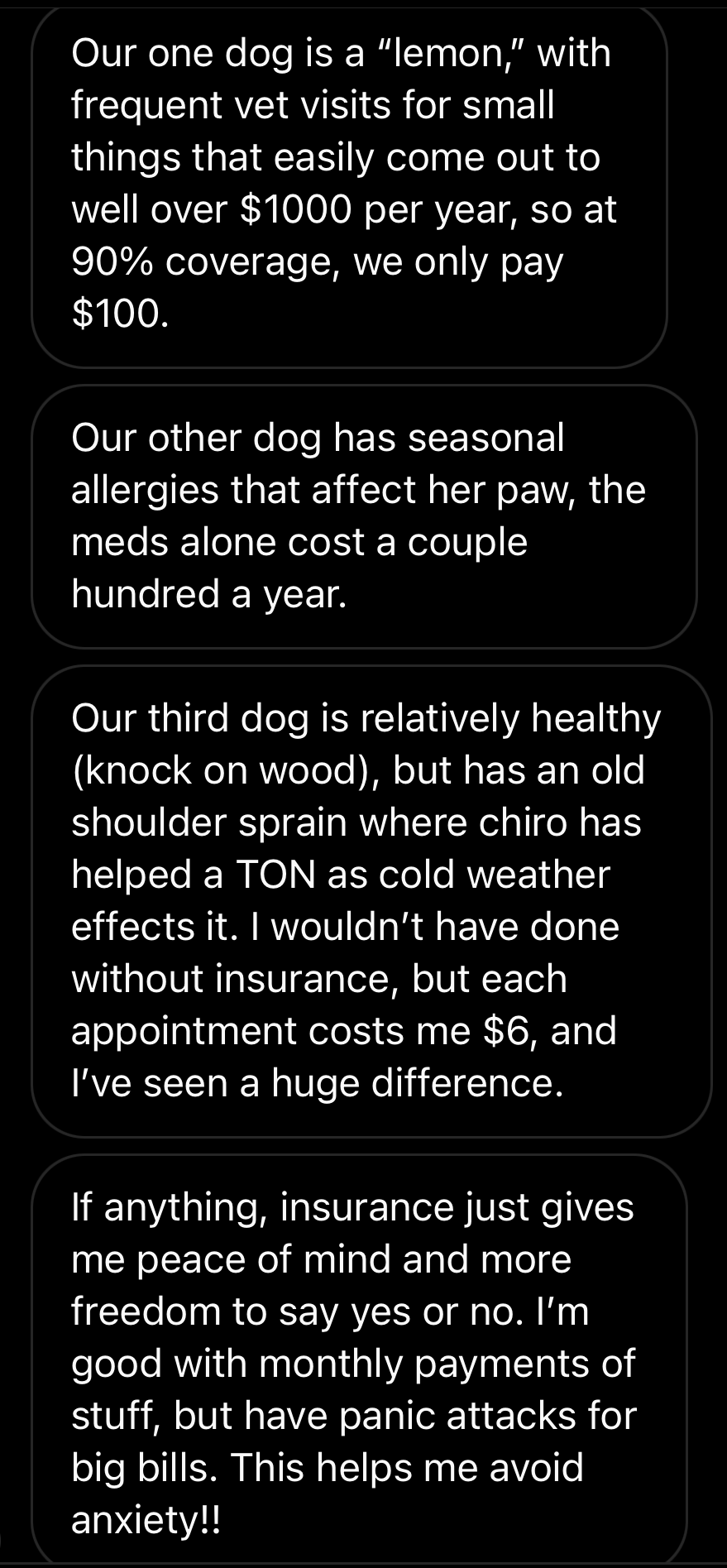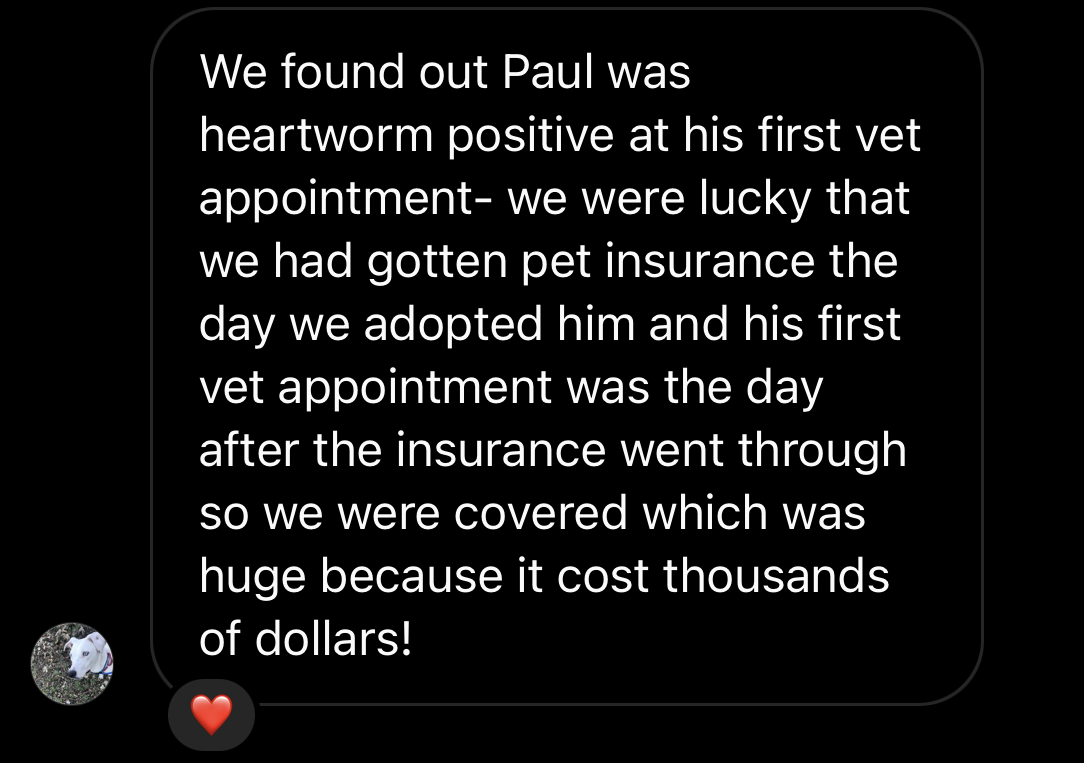Pet Insurance 101

As always, a disclaimer that we are not professionals in pet insurance, nor are we affiliated with any of the companies mentioned. All views, experiences, and opinions expressed are our own unless otherwise stated.
It’s no surprise to anyone who knows us that we’re passionate about Pet Insurance.
In fact, it’s turned out to be one of the most valuable things we’ve invested in for Cooper. Over the last few years I’ve noticed more pet owners making the choice to purchase pet insurance plans for their pup which is great to see–but I’ve also heard from many that they’re not sold yet. And I’m not surprised, to be honest.
Pet insurance, much like human insurance, is confusing, complicated, and variable. We spent a lot of time researching plans before landing on one ourselves and have gathered the experience of hundreds of other pet owners to hopefully shed some light on the pros and cons of purchasing a pet insurance plan, and how to decide when it’s worth it. Given our experience is only related to insuring a dog, we’ll be using dogs as our primary example. Before we get into the details of different plans, we’ll start with the most common questions we get about pet insurance.
Cooper at her sickest, prior to her Bartonella diagnosis
What we’ll cover
Benefits of pet insurance
Limitations of pet insurance
How to get started
When to get pet insurance
Options for pet insurance companies
Stories from our community
What even is pet insurance?
Pet insurance is, like human insurance, a healthcare plan that you pay for monthly in exchange for a percentage of vet bills being covered by the insurance company. Most pet insurance payments come in two forms: a premium which you pay every month, and a deductible which you must pay out of pocket before your insurance starts to cover your pet’s medical bills.
We’ll use our own policy as an example. Our monthly premium is about $65, and our annual deductible is $250. That means that we will pay no less than $65/month and $250 every year.
Ok, but how do I know what I’ll pay?
Pet insurance cost is dependent on several factors. Most take into account, at minimum, an animal’s species (cat or dog), breed (purebred or mixed breed), age, and your location.
When you visit a pet insurance company’s website, you can usually get an immediate quote by inputting this information into a form.
A pet insurance company typically has higher premiums for older dogs, purebred dogs, and dogs living in areas where the average cost of care is higher. However, your premium may vary from company to company. Your premium may also adjust (both higher and lower) in small increments annually given the age of your dog and the average cost of care in your area. Ours has gone from $70/mo year 1, to $65/mo year 2, and back and forth since.
Does pet insurance pay my vet directly?
In most instances, no. Pet insurance is largely based on reimbursement, meaning you foot the initial bill and are later paid back by the insurance company, usually within 30 days of the bill.
We’ve heard there are two companies (Trupanion and Healthy Paws) that have options to pay your vet directly, but be sure to read the policy details before committing to a company for this reason alone. Many times, companies will require pre-approval before paying the vet directly.
Sounds expensive. What’s the benefit of pet insurance? Does it actually help?
Every plan works differently, but generally you can expect your pet insurance to cover a certain percentage of costs after you’ve hit your annual deductible.
Here are a couple (maybe relatable?) examples of how this might play out:
The Sneaky Sock Stealer:
You wake up one morning and realize the pair of socks that had been on your floor is missing. Fido is pacing nervously and panting and you have a sneaking suspicion those socks have found a new home in Fido’s belly, and you’re worried they could do some damage. You take Fido to the vet, and the total bill for Operation Retrieve The Socks costs $1500. Let’s say your plan covers 90% of costs after your $250 deductible, and you’ve had no other expenses that year. You’d pay the first $250 of the $1500 leaving a $1250 bill in the balance. Your insurance would cover 90% ($1125) of that. Because you had insurance, a $1500 bill turns into a $375 bill. It’s still a tough cost to swallow, but might be a bit less tough than the lump cost of $1500.
The Surprise Stomach Sickness
Max’s stomach hasn’t been right recently. His stools are loose, he’s not as interested in his food, and he’s needing to go potty 3 times a night when he usually sleeps solidly from 10pm to 8am (lazy bones!). You decide to get it checked out by the vet, who discovers Max has an intestinal parasite that needs treatment. Max’s treatment will cost about $600. You already hit your $200 deductible at a previous vet visit (Max may have scraped his nose up at the dog park and needed treatment), and your insurance covers 80% of your $600 visit, leaving you with a $120 bill. You can skip your morning coffee for a month to make up for it.
The Dreaded “C” Word
You’ve had Bailey all her life, and she’s never had a real health problem. She’s 9 years old now, and you notice a few lumps and bumps have formed recently. At Bailey’s next appointment, the vet wants to run a few tests to be sure the bumps are just fatty tissue and nothing harmful. You get the results back and are devastated to find out Bailey has a form of cancer. Your vet is confident that treatment can give Bailey an extended lifespan with a good quality of life, and you agree that chemo (or some form of treatment) is the best option for Bailey. She’s only 9, after all, and you have a lot to look forward to with her. Your course of Chemo will cost about $10,000 all in. Let’s say your pet insurance policy covers 80% of all bills after your $500 annual deductible. You pay the $500 deductible, and then your insurance company pays 80% of the remaining $9,500 leaving you with an additional $1900 to cover out of pocket. $2400 is still $2400 more than you expected to pay on vet bills this year, but it’s more manageable than 10 grand.
If you’re really unlucky like us, you’ll panic about weird symptoms and end up spending $1,000 on vet bills for a gassy dog (thanks, insurance!)
So, how do people feel about pet insurance? Is it actually worth it?
We’re biased, so we wanted to get an answer from other pet owners. We surveyed our followers on Instagram and got a bit over a thousand responses. Here’s what we found:
Do people have pet insurance?
Of 1,000 respondents, 51% currently have pet insurance
Have you had to use your pet insurance in an emergency?
53% have had to use their insurance in an emergency
If you have pet insurance, do you feel it’s worth it?
88% feel it’s worth it
If you have pet insurance, would you get it again for your next pet?
97% would purchase pet insurance again for their next pet
If you do NOT have pet insurance, would you get it for your next pet?
83% would purchase pet insurance for their next pet
Overall, more people seem to be finding value in pet insurance. Many who don’t currently have it for an animal would consider it for another pet, and even though only about half of people with insurance have had to use it, the majority still feel it’s worth having.
If pet insurance is so great, why doesn’t everyone have it? Why wouldn’t it be right for me?
I want to start off by being very clear: you are not a bad owner if you don’t have pet insurance. There are many reasons why pet insurance may not be the right choice for someone, and I want to acknowledge that premiums are expensive. We are privileged to be able to afford that upfront cost, and we know that.
Because we have always had pet insurance, we wanted to hear from others why they’ve chosen to forego pet insurance. Here’s what we heard:
“I didn’t know it existed”
To be honest, I didn’t know it was a thing either before we got Cooper. As more companies are entering the D2C pet insurance space, you’ve more than likely seen an ad for a company that provinces pet insurance plans now, but this wasn’t the case even 5 years ago where there were fewer providers in the space.
“I’m overwhelmed with the options and can’t decide which company to go with”
I relate to this so much.We did so much research and honestly just ended up going with the most comprehensive option because we were overwhelmed. We are lucky it ended up being the right choice for us, but it might not have been! We’re hoping this article might provide a starting point for you if you’re feeling this way.
“It doesn’t seem worth it to me/costs are too high for the coverage”
This is valid. In my experience, one serious condition or vet emergency in a lifetime can make pet insurance financially beneficial, but you are ultimately placing a bet on if you’ll need it. It’s important to understand what’s the right decision for your situation.
“Insurance won’t cover my dog because of [pre-existing condition, age, etc.]”
We’ll get into this next - but, like human insurance, when pre-existing conditions are concerned, pet insurance doesn’t treat all dogs equally.
When is pet insurance not an option, and what are its limitations?
Pre-existing conditions
The most frustrating part of pet insurance is, coincidentally, one of the most frustrating parts of human health insurance. No pet insurance plan I could find meaningfully covers pre-existing conditions. That means if you adopt a dog later in life, or your dog develops a condition before you insure them, it is likely there will be conditions that are not covered by pet insurance plans. For example, if you adopt a dog that is already known to have allergies and you get insurance for them, it is unlikely a pet insurance plan will cover any condition or procedure related to allergies. However, if you adopt a dog with no known allergies, insure the dog, and then discover the dog has allergies, they will be covered. It can be frustrating.
Senior pets
We mentioned earlier that the cost of your premium can depend on your pet’s age. Unfortunately, this means that many plans for senior pets are incredibly expensive, with premiums rising to $200/month or more. At this cost, it’s possible that insurance isn’t the best option for you. We know many people who opt to, instead, put the cost they’d pay for pet insurance premiums into an “emergency fund” for their pet every month. Even with an insurance policy, an emergency fund is a great idea.
Select procedures/conditions
The best thing you can do when looking for insurance is to read your plan details thoroughly. There will be limitations. Some plans cover dentals, some plans don’t. Some plans have waiting periods before they’ll cover certain conditions, others don’t. Some plans include coverage for vet fees. No plan will cover line items for things like “medical waste disposal”. Make sure you have a great understanding of exactly which costs on your bills will be covered.
Spay/Neuter
Most insurance plans won’t cover spaying/neutering for your pup.
Conditions due to neglecting to use preventative medications/vaccinations
Most insurance plans won’t cover anything that comes up because you’ve neglected to vaccinate your dog or use appropriate prevention.
When’s the right time to get pet insurance?
If you’re considering pet insurance and there’s one thing to take away from this article, have it be this: Get pet insurance before you think you need it. We’ve mentioned that pre-existing conditions aren’t often covered, and that the older a pet is, the more expensive a plan can be. We’ve found that to get the best coverage, insuring your pet early when they’re healthy is the most helpful. This can seem counterintuitive– why would I want to pay for insurance for a healthy animal? But unfortunately, if you wait until you need coverage it’s often too late due to the restrictions on pre-existing conditions. We had the philosophy that we’d rather pay a small amount of money monthly to prepare for later-in-life expenses than pay a lump sum all at once with no coverage.
We definitely did NOT anticipate Cooper racking up over $30,000 in vet bills at age two. But life happens. Unexpected emergencies happen. Having pet insurance can make a hard decision in an emergency a little easier. Speaking from experience, when I was asked to sign away our preferences for resuscitation in the event Cooper– a dog who was 2 years old and healthy the day before– didn’t make it through the night in the ICU, the last thing I wanted to be worried about was what the bill was going to be.
If you’re thinking about getting pet insurance, and it makes financial sense for you, don’t wait.
I’m starting to think I should get pet insurance. But where do I start? How do I pick a plan?
There are a few things to consider when choosing a pet insurance plan or provider. Some key things that we’ve found helpful:
Understand the difference between wellness plans and medical plans, and if you want one or both.
Many pet insurance companies offer both major medical plans and wellness plans, and they generally serve different needs.
Major Medical, or medical plans are by far the most popular and common ones based on people we’ve spoken to. These are the plans you think about when you think of insurance: The ones that cover broken legs, a dog eating foreign objects, cancer, etc. Read the policy to be sure of the details for the specific company and plan you’re looking at, but that’s the nuts and bolts of a medical plan. There’s one big thing these things don’t cover, and that’s any preventative or wellness expense. Which brings us to…
Wellness plans. Wellness plans are usually standalone or add-on plans that cover preventative medicine. Things like heartworm + flea and tick medication, your annual vet visit, vaccines, etc. Many of these plans will cover the cost of the vet visit itself which can be beneficial depending on where you live (in our area, these are between $75-$90 for regular vet visits, and ~$150 for emergency vets). Some of these plans will even cover prescription dog food, vet behaviorist visits, physical therapy, and much more. Definitely read the plan coverage details.
Know what coverage you want.
Not all plans are created equally. Many will have annual maximums, lifetime maximums, or maximums by condition. It’s important to decide what’s important to you. Is it no lifetime maximums for any condition, and you’re willing to pay a little more for that, or are you just fine with some coverage or annual maximums of $10,000? Cost, coverage, and plans will vary company by company.
Decide what monthly payment makes the most sense for you.
You can usually choose plans to minimize your monthly payment. It might mean your deductible is higher, and your insurance covers a lower percent of your costs, though. It’s a good idea to work out what your “non-negotiables” are in terms of cost/coverage.
Know that most policies have a “waiting period”.
This means that coverage often doesn’t go into effect immediately- some companies require a 2 week - 1 month “waiting period” before covering anything. Any conditions that develop in that time are generally considered a pre-existing condition.
What’s the best pet insurance company?
Unfortunately there’s no cut and dry answer to this question, and the best pet insurance plan for us might not be the best plan for you. As you’ve gathered by now, there’s a lot of variability in plans. What we can help with, though, is a list of companies that have been positively reviewed to us as well as our own experience. Remember that everyone has a different experience with insurance companies- it can even come down to the person you get on the phone that day- so you’re likely to hear mixed reviews for each of these.
Nationwide (what we have)
We never had Nationwide when they were VPI and we’ve heard not so great things from those times, but this is the insurance company we decided to go with for Cooper. We have always had positive experiences with Nationwide and haven’t heard many bad things from others who also use them. We have the Whole Pet + Wellness plan through them, which is pretty much the Cadillac of pet insurance plans, including both medical + wellness. We pay for 90% coverage with no lifetime or annual maxes and appreciated how robust the coverage was, that diagnostics and dentals were included. Nationwide reimburses expenses and does not pay the vet directly. We’ve always been reimbursed within 30 days, and have been able to get help through customer service when we had questions. Our policy has shifted up and down about $5-$10 in the 4 years we’ve had it. We have had over $40,000 in vet bills reimbursed since we started using Nationwide (we’ll write that story another day) without any issues. Our vet uses a claim form on hand and they submit bills for us.
You can get an initial quote and explore plan details on their website. We pay $65/month with a $250 deductible and 90% reimbursement for a 5-year-old, 40lb mixed breed dog for unlimited payouts for a medical/wellness plan. IF we enrolled her today, at 5, that plan would be about $80.
For a 2-year-old mixed breed in Brooklyn:
Healthy Paws (recommended by our audience)
We don’t have personal experience with Healthy Paws but many who responded to our survey had amazing things to say about it. They appear to have similar coverage to some of Nationwide’s plans. They tout having no limits on any plans per-incident, or any annual/lifetime caps on payouts and you upload your vet bills to them directly. They claim to have superior customer service.
Notable: I went through their quote simulator with our info and they say they weren’t able to provide us service, but when I said Cooper was 2 rather than 5, they magically could. This definitely wasn’t the case when I researched them 4 years ago.
For a 2-year-old mixed breed in Brooklyn: (This did not include preventative care or vet fees. Their sample plan states a 15 day waiting period and seems to indicate they wouldn’t cover injuries similar to ones that occurred prior to the plan coverage, and that they wouldn’t cover any cruciate ligament issues if they had previously occurred before coverage.)
Trupanion (recommended by our audience)
We don’t have personal experience with Trupanion but many who responded to our survey had amazing things to say about it. Off the bat, their coverage appears more expensive than Healthy Paws or Nationwide for similar coverage, and they only have one overall plan, but they do offer “price customization” features that could help if you’re looking to budget, and additional plans around “recovery” and “owner assistance”. They do not offer plans that cover exam fees and have a 30 day waiting period.
In conclusion…
We always talk about pet insurance as an investment- and one that you maybe hope you lose. Ideally, you never have a scary vet visit that sets you back a few thousand dollars. But oftentimes, at some point in our dogs’ lives, they will. Whether we prepare for that with an insurance plan or an emergency fund, it’s good to plan for the unexpected. We’re not shy about the fact that Cooper would’ve died due to a lack of funds available to continue the diagnostic efforts required to get to the bottom of her condition. I never could’ve known how impactful an impulse decision to purchase an insurance plan could’ve been. I can’t assume to know pet insurance is the right choice for every person, but I hope we’ve been able to provide an objective view of it here. Have any questions? Stories of your own? Please don’t hesitate to reach out to us.





























